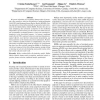331 search results - page 31 / 67 » Dining Activity Analysis Using a Hidden Markov Model |
MONET
2007
13 years 8 months ago
2007
This paper explores the potential for use of an unaugmented commodity technology—the mobile phone— as a health promotion tool. We describe a prototype application that tracks t...
BMCBI
2007
13 years 8 months ago
2007
Background: Yu et al. (BMC Bioinformatics 2007,8: 145+) have recently compared the performance of several methods for the detection of genomic amplification and deletion breakpoin...
CVIU
2006
13 years 8 months ago
2006
We present algorithms for recognizing human motion in monocular video sequences, based on discriminative Conditional Random Field (CRF) and Maximum Entropy Markov Models (MEMM). E...
UCS
2007
Springer
14 years 2 months ago
2007
Springer
Abstract. This paper describes daily life activity recognition using wearable acceleration sensors attached to four different parts of the human body. The experimental data set con...
HUC
2010
Springer
13 years 8 months ago
2010
Springer
This work presents the design and evaluation of an activity recognition system for seven important motion related activities. The only sensor used is an Inertial Measurement Unit ...


